#Mary Duchess of Gloucester
Text
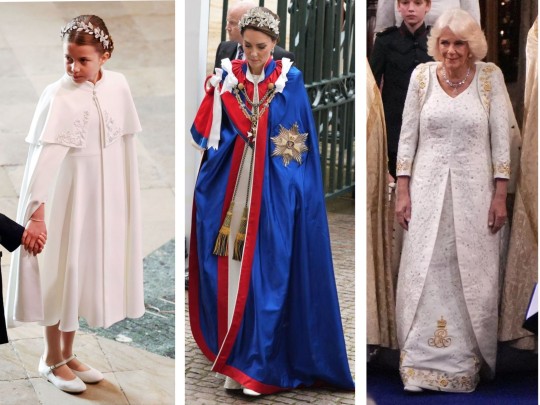

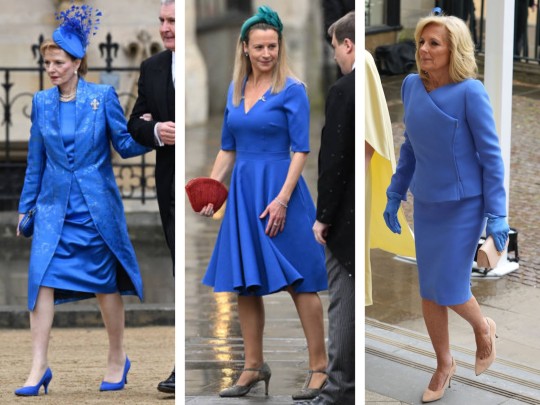





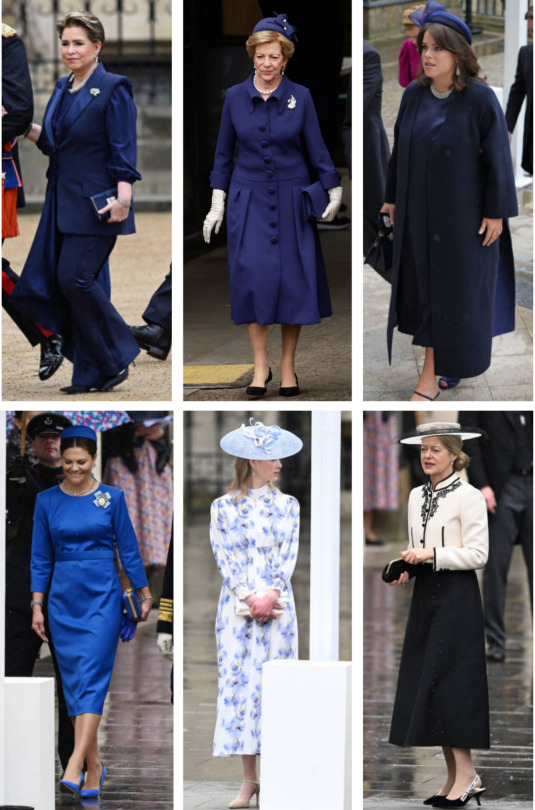
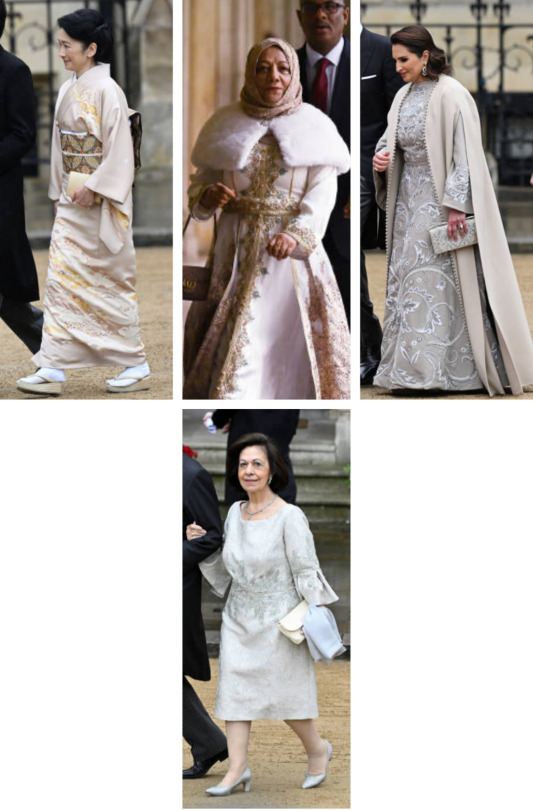
THE FASHIONISTAS
6 MAY 2023 || The fashion of the Royal Ladies and other Guests at the Coronation of King Charles III at Westminster Abbey in London.
#the fashionistas#the fashionistas 23#the actual big day#princess of wales#princess catherine#queen letizia#crown princess mary#crown princess mette marit#crown princess victoria#duchess of edinburgh#duchess of gloucester#queen camilla#princess charlotte#carole middleton#pippa middleton#zara tindall#olena zelenska#jill biden#queen maxima#queen mathilde#katy perry#queen jetsun pema#hereditary princess sophie#queen suthida#grand duchess maria teresa#queen anne marie#princess eugenie#princess beatrice#crown princess marie chantal#lady louise windsor
679 notes
·
View notes
Text

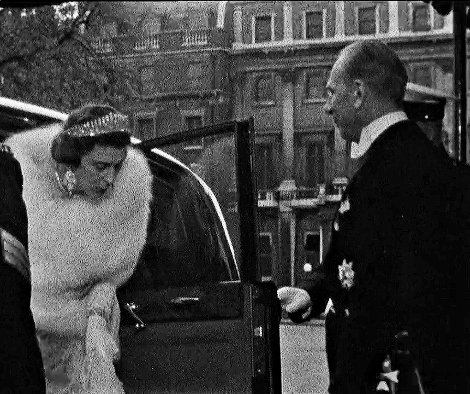


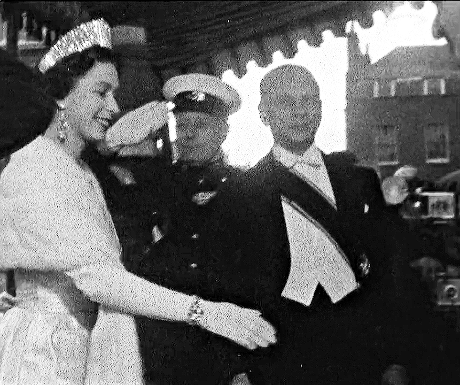


14 May 1958
President Giovanni Gronchi state visit day two: Royals arriving at the Italian Embassy, Grosvenor Square, London
© ITN
#queen elizabeth ii#prince philip#duke of edinburgh#queen mother#princess margaret#princess alice duchess of gloucester#prince henry duke of gloucester#princess marina duchess of kent#princess mary princess royal
100 notes
·
View notes
Text


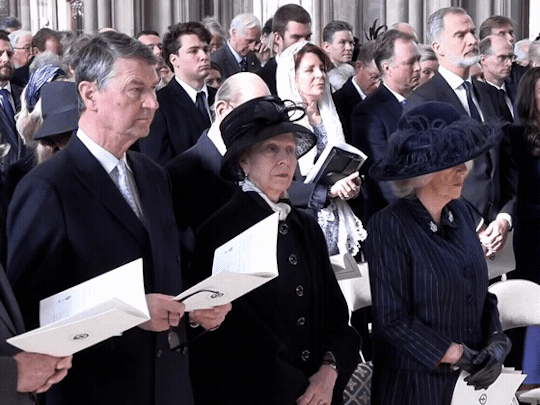


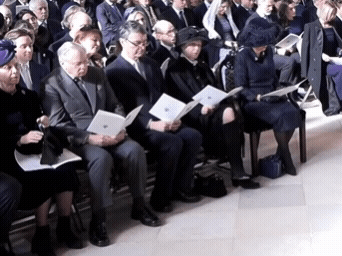

Princess Anne and her husband, Sir Tim Laurence, alongside other members of the Royal Family attend the Thanksgiving Service for King Constantine II at St George's Chapel, on 27 February 2024.
#🥺🥺🥺#princess anne#princess royal#tim laurence#timothy laurence#duke of gloucester#duchess of gloucester#queen camilla#queen anne marie#crown prince pavlos#king felipe vi#queen letizia#brf#british royal family#greek royal family#spanish royal family#my gifs
35 notes
·
View notes
Text

Members of the British Royal Family attend the coronation of King George VI and Queen Consort Elizabeth, 1937.
#queen mary#mary of teck#queen mary of teck#princess mary#princess royal#countess of harewood#george vi#king george vi#princess elizabeth#queen elizabeth ii#elizabeth ii#Princess Margaret#Duchess of Gloucester#Princess Alice#Princess Marina#Duchess of Kent#Queen Maud#queen maud of norway#Queen Elizabeth#queen elizabeth the queen mother#Queen mother#coronation
117 notes
·
View notes
Text
The Marriage of Henry of Lancaster and Mary de Bohun (1380/1)
From: Chronicles of England, France and Spain and the Surrounding Countries, by Sir John Froissart, Translated from the French Editions with Variations and Additions from Many Celebrated MSS, by Thomas Johnes, Esq; London: William Smith, 1848. *
Humphry, earl of Hereford and Northampton, and constable of England, was one of the greatest lords and landholders in that country; for it was said, and I, the author of this book, heard it when I resided in England, that his revenue was valued at fifty thousand nobles a-year. From this earl of Hereford there remained only two daughters as his heiresses; Blanche the eldest, and Isabella** her sister. The eldest was married to Thomas of Woodstock, earl of Buckingham. The youngest was unmarried, and the earl of Buckingham would willing have had her remain so, for then he would have enjoyed the whole of the earl of Hereford’s fortune. Upon his marriage with Eleanor, he went to reside at his handsome castle of Pleshy, in the county of Essex, thirty miles from London, which he possessed in right of his wife. He took on himself the tutelage of his sister-in-law, and had her instructed in doctrine; for it was his intention she should be professed a nun of the order of St. Clare***, which had a very rich and large convent in England. In this manner was she educated during the time the earl remained in England, before his expedition into France. She was also constantly attended by nuns from this convent, who tutored her in matters of religion, continually blaming the married state. The young lady seemed to incline to their doctrine, and thought not of marriage.
Duke John of Lancaster, being a prudent and wise man, foresaw the advantage of marrying his only son Henry, by his first wife Blanche, to the lady Mary: he was heir to all the possessions of the house of Lancaster in England, which were very considerable. The duke had for some time considered he could not choose a more desirable wife for his son than the lady who was intended for a nun, as her estates were very large, and her birth suitable to any rank; but he did not take any steps in the matter until his brother of Buckingham had set out on his expedition to France. When he had crossed the sea, the duke of Lancaster had the young lady conducted to Arundel castle; for the aunt of the two ladies was the sister of Richard, earl of Arundel, one of the most powerful barons of England.**** This lady Arundel, out of complaisance to the duke of Lancaster, and for the advancement of the young lady, went to Pleshy, where she remained with the countess of Buckingham and her sister for fifteen days. On her departure from Pleshy, she managed so well that she carried with her the lady Mary to Arundel, when the marriage was instantly consummated between her and Henry of Lancaster. During their union of twelve years, he had by her four handsome sons, Henry, Thomas, John and Humphrey, and two daughters, Blanche and Philippa.
The earl of Buckingham, as I said, had not any inclination to laugh when he heard these tidings; for it would not be necessary to divide an inheritance which the considered wholly as his own, excepting the constableship which was continued to him. When he learnt that his brothers had all been concerned in this matter, he became melancholy, and never after loved the duke of Lancaster as he had hitherto done.^
Notes:
* Johnes notes that this is from "only one of [his] mss. [manuscripts] and not in any printed copy". Chris Given-Wilson (Henry IV, Yale University Press, 2016): "This story comes from a variant manuscript of Froissart's chronicles used by Johnes, but subsequently destroyed by fire."
** Johnes: "Froissart mistakes: their names were Eleanor and Mary." Presumably, Johnes then corrects their names for the rest of the narrative?
*** Jennifer C. Ward (translator and editor), Women of the English Nobility and Gentry: 1066-1500 (Manchester Medieval Sources, Manchester University Press, 1995): "This is probably a reference to the convent of the Minoresses outside Aldgate in London where Isabella, daughter of Thomas and Eleanor, later became a nun."
**** Ward: "Joan de Bohun, Mary’s mother, was the sister of Richard FitzAlan, earl of Arundel." Given-Wilson argues the role Froissart assigns to Mary's aunt was actually played by Joan.
^ The veracity of Froissart's account has tended to be questioned, with some historians generally concluding there was probably some truth, mostly revolving around the falling out between John of Gaunt and Thomas of Woodstock over the marriage. The secretive nature of it is almost certainly untrue, given Gaunt had received a royal grant for Mary's marriage. Given-Wilson:
Froissart claimed that ‘the marriage was instantly consummated’, but this was precipitate. He also got several other details of the story wrong, such as calling the two sisters Blanche and Isabel and saying that it was their ‘aunt’ who carried Mary away from Pleshey, but the essentials of his story are corroborated by other sources and undoubtedly correct. Countess Joan was complicit in the plot, presumably hoping to give her daughter a life outside the convent. She probably commissioned a pair of illuminated psalters for the marriage.
The psalters were probably made by the de Bohun-sponsored workshop at Pleshey, one of Woodstock's principle residences. It's possible, presumably, that Joan commissioned them after the wedding but if they were commissioned before/finished by the time of the wedding, it's hard to imagine that Woodstock's household were entirely unaware that a move was being made to marry Mary to Henry.
#mary de bohun#henry iv#jean froissart#joan de bohun countess of hereford#eleanor de bohun duchess of gloucester#thomas of woodstock duke of gloucester#john of gaunt#primary source#froissart's chronicles
9 notes
·
View notes
Photo
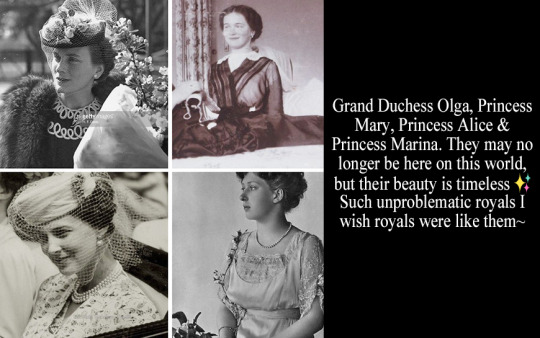
“Grand duchess Olga, princess Mary, Princess Alice & princess Marina. They may no longer be here on this world, but their beauty is timeless ✨ 👑 Such unproblematic royals I wish royals were like them~” - Text & Image Submitted by abigaaal
#grand duchess olga nikolaevna#mary princess royal#princess alice duchess of gloucester#princess marina#abigaaal#popular
46 notes
·
View notes
Note
among her daughters-in-law alice duchess of gloucester, queen mother aka duchess of york, princess marina duchess of kent.
with whom she had the best relationship?
i know she disliked simposon duchess of windsor
Hi @abigaaal !
You are certainly correct! I think we can all agree without a shred of doubt that QM did NOT like Wallis Simpson!
As for the rest of her daughters-in-law I do believe she liked and got on well with all of them. I know Elizabeth and Alice referred to QM as ‘darling Mama’ though I have not seen Marinas letters, and I think referring to your mother-in-law as ‘mama’ in such high society circles was fairly common. I know Princess Mary also referred to her own M-I-L in such fashion, as did QM with Queen Alexandra.
From what I have read, my opinion is that Alice of Gloucester was her favourite, followed by Elizabeth then Marina - however I think the margin between all of them was very small. She had things in common with all them though I think she found Alice the most down-to-earth.
She had certainly known Elizabeth the longest as she married Bertie in 1923, and Alice and Marina didn’t appear on the scene until the early to mid 1930s respectively. Elizabeth as I understand it was the undisputed favourite of George V, though this may be because he died so early into the marriages of his two younger sons. Though in the days Bertie was proposing to Elizabeth (3 times!! so yes I do mean days - if not months and years) QM as I understand was very very keen for Elizabeth to say yes as she thought she’d be a fantastic match for Bertie. And much later on she knew undoubtedly that Elizabeth would be a wonderful Queen.
We know Alice and QM were close only I think because of the memoir written by Alice (which is FABULOUS btw - if you haven’t read it I would absolutely recommend it). Marina however doesn’t have the luxury of being as well written about unlike her sisters-in-law, with one being a Queen of England and the other as I’ve mentioned writing her own story, though by all means Alice was still discreet. So when it comes to Marina I’m afraid we know a little less about her relationship with QM. I also have to confess I’m not much of an expert when it comes to Marina, if anyone else has any light to shed on it please do comment!
Ultimately, I think she liked each D-I-L for who they were and how happy they made her sons (and of course they were of the appropriate marrying variety unlike Simpson).
Hope this helps! ♥️
#ask me anything#british royal family#brf#queen mary#george v#mary of teck#queen elizabeth the queen mother#Queen mother#princess marina#Duchess of kent#Duchess of Gloucester#princess alice#alice Duchess of Gloucester#Marina Duchess of kent
10 notes
·
View notes
Text

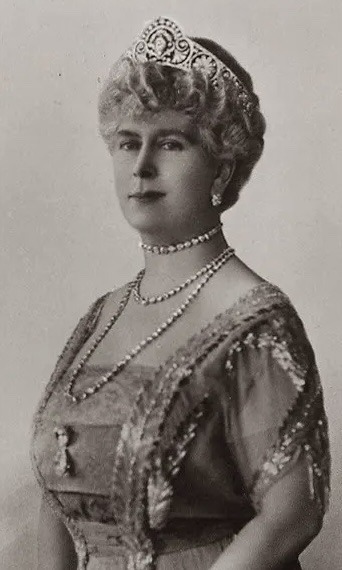
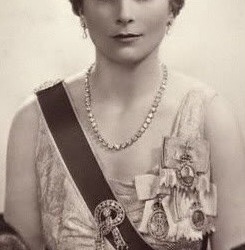

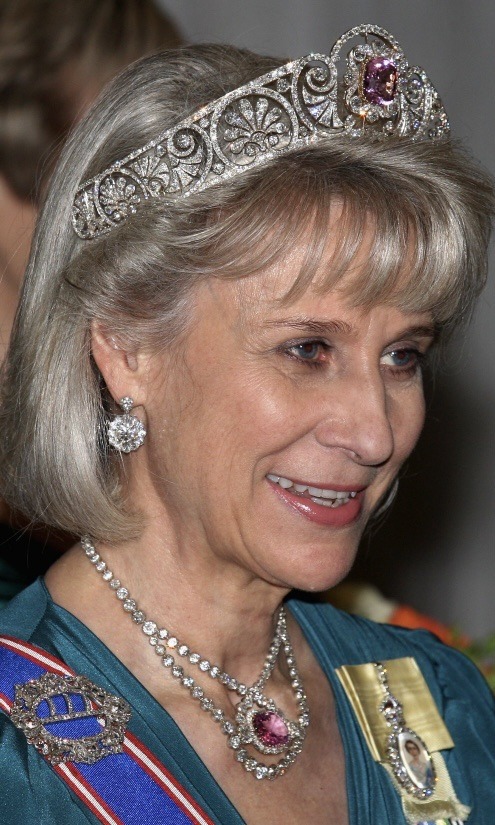
Royal Tiaras Highlights: Queen Mary’s Honeysuckle Tiara
The tiara was made by E. Wolff and Co. on a commission from Garrard, and at the request of Queen Mary of the United Kingdom in 1914. The tiara used some recycled royal diamonds, taken from the County of Surrey Tiara and the Ladies of England Tiara. It’s a very flexible piece as the central element of the tiara is able to accommodate several different stones.
In 1935, Mary gave the tiara to her new daughter-in-law, Lady Alice Montagu Douglas Scott, when she married Prince Henry, Duke of Gloucester. Along with the tiara, Alice received three stones that can be used on the center of the piece: a diamond, an emerald and a kunzite. Princess Alice eventually passed on the tiara to her own daughter-in-law, Birgitte, the current Duchess of Gloucester.
31 notes
·
View notes
Text
The Duchess of Teck’s Collet Necklace.
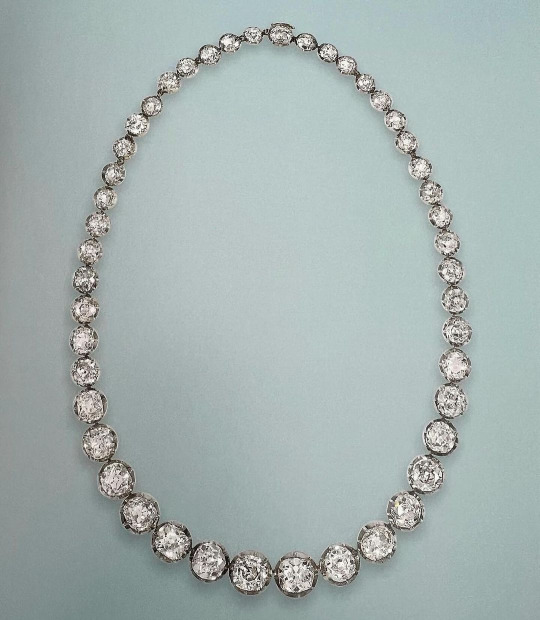
It is likely that this necklace (or the greater part of the stones now in it) came to Princess Mary Adelaide, Duchess of Teck, from her aunt, Princess Mary, Duchess of Gloucester.
A year later, on the Duchess of Gloucester’s death, the Princess also received from her aunt her ‘single row of diamonds’, in addition to other jewellery. A later inventory of Princess Mary Adelaide’s jewellery records the legacy from the Duchess of Gloucester as ‘A Diamond Necklace of 49 Diamonds, and clasp of small Diamonds’, which is probably to be identified with this necklace.
The necklace was bequeathed by Queen Mary to Queen Elizabeth, The Queen Mother, and was inherited by Queen Elizabeth II in 2002.
#The Duchess of Teck’s Collet Necklace#british royal family#jewel;necklace#queen elizabeth ii#queen mary#the queen mother#thejewelcatalogue
117 notes
·
View notes
Text

TIARA ALERT: The Duchess of Gloucester wore Queen Mary's Honeysuckle Tiara for a banquet on the second night of the state visit from South Korea at the Guildhall in London on 22 November 2023.
#Tiara Alert#Duchess of Gloucester#United Kingdom#British Royal Family#tiara#pink topaz#honeysuckle tiara#diadem#royal jewels#royaltyedit
194 notes
·
View notes
Text
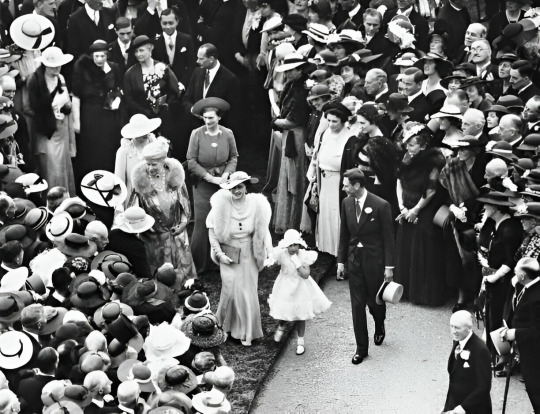
Royal Garden Party At Buckingham Palace. King George VI, Queen Elizabeth, Princess Margaret and Queen Mary of Teck attend a royal garden party held in the garden at Buckingham Palace in London on 22nd July 1937. Behind are Prince Henry, Duke of Gloucester and his wife Princess Alice, Duchess of Gloucester.
#ktd#brf#british royal family#Black and white#king George vi#queen elizabeth#princess margaret#queen mary
24 notes
·
View notes
Text
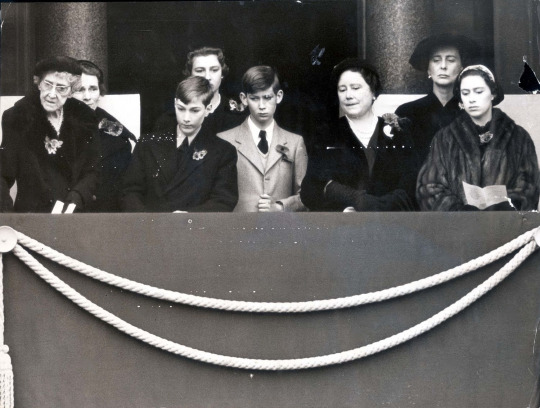
November 1955
Members of the Royal Family on the Balcony of the Home Office at the Cenotaph: [L-R] Princess Marie Louise, Duchess of Gloucester, Prince William of Gloucester, Princess Alexandra of Kent, Prince Michael of Kent, The Queen Mother, Duchess of Kent, and Princess Margaret
#queen mother#princess margaret#princess alice duchess of gloucester#princess marina duchess of kent#princess alexandra of kent#prince william of gloucester#prince michael of kent#princess marie louise#british royal family#remembrance
35 notes
·
View notes
Text
Queen Mary, Princess Elizabeth and the Duke of Edinburgh, Prince Charles and Princess Anne, Princess Margaret, the Duke and Duchess of Gloucester, Prince William and Prince Richard, Princess Mariana, Duchess of Kent, the Duke of Kent, Princess Alexandra and Prince Michael joined King George VI and Queen Elizabeth for Christmas at Sandringham 🏰 🎄


This was the King's last Christmas before his death a few weeks later.
44 notes
·
View notes
Text

Members of the British Royal Family, 1940s.
#queen mary#mary of teck#queen elizabeth ii#elizabeth ii#princess elizabeth#princess margaret#king george vi#george vi#queen elizabeth the queen mother#queen mother#Queen Elizabeth#princess marina#Duchess of Kent#prince henry#duke of gloucester#princess mary#princess royal#countess of harewood#1940s
41 notes
·
View notes
Text
One account of Mary’s household, from 1387-88, survives, and gives insight into her day-to-day life. It shows her busy making clothing for herself and her children, as well as a riding gown for her husband. On Maundy Thursday in 1388 Mary provided gowns for eighteen poor women and purchases of an apron and towel for her to wear for the same day indicate that Mary herself played a public role in the ceremonies. Multiple references to Mary wearing blue and white show her participating in the public display of family identity. She also made an effort to stay abreast of current events and her husband’s activities, making sure that she got updates from the parliament held at Cambridge in September 1388. Mary also communicated with John of Gaunt’s household, for instance corresponding with Gaunt’s chamberlain, Richard Abberbury. She travelled to London at some point that year, as her accounts show her shopping with her sister Eleanor on Bread Street (just behind St Paul’s Cathedral) and purchasing a pair of tongs and four collars of leopards. Like the other members of her family she participated in public displays of wealth and power: Herman Goldsmith (who also worked for John of Gaunt and Henry of Bolingbroke) was paid to make collars, rings and a coronet.
Rebecca Holdorph, ‘My Well-Beloved Companion’: Men, Women, Marriage and Power in the Earldom and Duchy of Lancaster, 1265-1399, University of Southampton, PhD Thesis
#mary de bohun#henry iv#eleanor de bohun duchess of gloucester#historian: rebecca holdorph#love the idea of mary and eleanor going shopping in london#buying tongs.#i'm not sure mary was making the clothes herself
3 notes
·
View notes
Text
The King on St George’s Day has made appointments to the orders of the Garter (the Duchess of Gloucester), the British Empire (the Queen), the Bath (the Prince of Wales) and the Companions of Honour (the Princess of Wales).
All are effective from today, 23 April.
THE ORDER OF THE GARTER
His Majesty The King has been graciously pleased to appoint four new Companions to the Order of the Garter. The Companions are:
Her Royal Highness The Duchess of Gloucester, GCVO, DStJ, CD, to be a Royal Lady Companion of the Most Noble Order of the Garter.
Air Chief Marshal the Lord Peach, GBE, KCB, DL, to be a Knight Companion of the Most Noble Order of the Garter.
The Right Honourable the Lord Kakkar, KBE, to be a Knight Companion of the Most Noble Order of the Garter.
The Lord Lloyd-Webber to be a Knight Companion of the Most Noble Order of the Garter.
THE MOST EXCELLENT ORDER OF THE BRITISH EMPIRE
His Majesty The King has been graciously pleased to appoint Her Majesty The Queen to be Grand Master and First or Principal Dame Grand Cross of the Most Excellent Order of the British Empire.
Previous Grand Masters have included: His Royal Highness Prince Philip, Duke of Edinburgh (1953-2021), Her Majesty Queen Mary (1936-1953) and His Majesty King George Vl as The Prince of Wales (1917-1936).
The Order of the British Empire was established by King George V in 1917 to honour a broader cross section of society, both military and civilian.
THE MOST HONOURABLE ORDER OF THE BATH
His Majesty The King has been graciously pleased to appoint His Royal Highness The Prince of Wales, K.G., K.T., A.D.C., to be Great Master of the Most Honourable Order of the Bath.
Previous Great Masters have included: His Majesty The King as The Prince of Wales (1974-2022), His Royal Highness Prince Henry, Duke of Gloucester (1942-1974) and His Royal Highness Prince Arthur, Duke of Connaught and Strathearn (1901-1942).
The Most Honourable Order of the Bath was established bv Kina Georae I in 1725 althouah it is believed to oriainallv date back as far as the eiahth centurv. It is awarded to members of the military or civil service for exemplary service.
THE ORDER OF THE COMPANIONS OF HONOUR
His Majesty The King has been graciously pleased to appoint Her Royal Highness The Princess of Wales, GCVO, to be Royal Companion of The Order of the Companions of Honour.
This is a new appointment.
The Order of the Companions of Honour was founded by King George V in 1917 to recognise outstanding achievements in the Arts, Sciences, Medicine and Public Service.
#new appointments!!!#so happy to see birgitte be honoured!!!#birgitte duchess of gloucester#queen camilla#william prince of wales#catherine princess of wales
19 notes
·
View notes